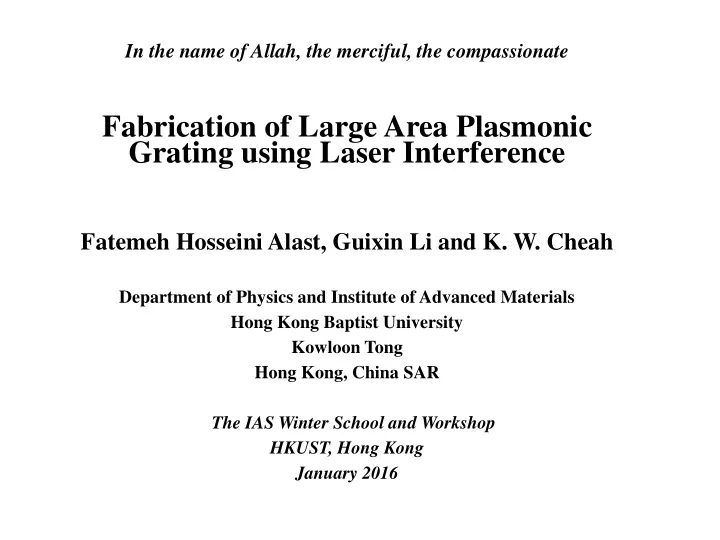

In the name of Allah, the merciful, the compassionate Fabrication of Large Area Plasmonic Grating using Laser Interference Fatemeh Hosseini Alast, Guixin Li and K. W. Cheah Department of Physics and Institute of Advanced Materials Hong Kong Baptist University Kowloon Tong Hong Kong, China SAR The IAS Winter School and Workshop HKUST, Hong Kong January 2016
Content Introduction Photolithography Lithography Interferometry Liftoff Technique Device Characterization Plasmonic cavity Theory Application Cavity structure Results Conclusion
Introduction The surface plasmon polariton (SPP) A quantum of a charge- density wave of free electrons on a metal/dielectric interface. No excitation of SPP at the flat metal/dielectric interface According to the dispersion relation at the metal/dielectric k k 1 2 dielectric 0 1 2 The array of apertures at the metal/dielectric interface It serves to couple incident light with SPPs at the interface Stefan A. Maier, “PLASMONICS: FUNDAMENTALS AND APPLICATIONS”, Springer 2007
Introduction Effective parameters on coupling strength The hole size Lattice spacing Metal film thickness Angular dispersion The metal type The symmetry role in the dielectric/metal/dielectric layer stack The lattice finite-size The hole shape F.J. Garcia-Vidal, L. Martin-Moreno, T.W. Ebbesen, L. Kuipers, Reveiws of Modern Physics, 82, 729, (2010).
Photolithography Lithography Radiation Recording photosensitive film Optical Mask structure properties changes under light exposure. Positive resists generally have better Immersed substrate into developer resolution than do negative resists. solution Positive photoresist Negative photoresist Nicolas F. Borrelli ,“ Microoptics Technology”, CRC Press 2004.
Photolithography Michelson Interferometer Using Optical Mask Two equal laser beams Equal optical length for each interferometer arm Constructive interference Destructive interference Pitch size relation of grating Screen He-Cd laser with 442 nm Mirror 1 Illumination Area: 10 x 10 mm 2 Laser Tuning of pitch size by two Beam splitter beams interference angle Mirror 2 Eugene Hecht, “Optics” 4 th ed., Addison Wesley, (2002).
Photolithography
Photolithography Liftoff Technique Metal Evaporation Liftoff excess Lithography Spin Coating coating metal with PR of PR Nicolas F. Borrelli ,“ Microoptics Technology”, CRC Press 2004.
Photolithography Device Characterization Ellipsometric measurement and calculation (b) (a) 60 60 1.1 1.0 65 65 1.0 70 0.8 70 0.9 75 75 0.6 0.8 0.4 Cos (Delta) 0.7 Tan (Psi) 0.2 0.6 0.0 0.5 -0.2 0.4 -0.4 0.3 -0.6 0.2 -0.8 0.1 -1.0 300 400 500 600 700 800 300 400 500 600 700 800 Wavelength (nm) Wavelength (nm) Reflective amplitude (a) and phase (b) variation, calculation SPP modes (c) for different angle SEM image. (c) Λ ~360nm
Plasmonic cavity Theory When electromagnetic field interacts with a matter like a single emitter, the following intractions can be found: Two different regimes: i. Strong coupling regime: This is dominated by coupling constant of interaction. ii. Weak coupling regime: the damping rates are dominated. Aspect of Nano-quantum Optics, Ch. 9, Nano optics.
Plasmonic cavity Theory Strong Plasmon-Cavity coupling Rabi-like splitting Supposing the surface plasmon as two level system using dipole moment approximation with single mode cavity. According to phase matching, no surface modes exist for TE polarization so there is just TM mode SPP coupling at the surface Ralf Ameling,Harald Giessen,” Microcavity plasmonics: strong coupling of photonic cavities and plasmons ” Laser Photonics Rev., 1 – 29 ,2012.
Plasmonic cavity Application Reducing the pumping threshold of polariton lasing Controlling the energy redistribution pathways in molecules and tailoring the resonance energy of excitons in semiconductor materials The coupled photonic – plasmonic systems The organic – plasmonic hybrid system THz metamaterials Controlling the energy distribution channels in a hybrid plasmonic nanocavity Shumei Chen, Guixin Li, Kok Wai Cheah , “Efficient energy exchange between plasmon and cavitymodes via Rabi-analogue splitting in a hybrid plasmonic nanocavity ” Nanoscale, 2013, 5, 9129.
Plasmonic cavity Device structure Thermal evaporation silver Spin coating PMMA and Photoresist Making grating on photoresist by photolithography Grating height ~ 15nm with pitch size ~ 370nm Cavity dimension: 10 x 10 mm 2
Plasmonic cavity Experimental Results Coupling took place at 717nm, E=44 meV No coupling occured Cavity length ≈ 210 nm Pitch size ≈ 370 nm Anti-crossing degree ≈ 52 Anti-crossing wavelength ≈ 717 nm Linewidth of splitting ≈ 17.5 nm ~ 44mev
Conclusion The ruled grating was fabricated with high surface quality and uniformity in large area. The grating performance was examined with SPPs excitation at the metal/dielectric interface for different angles by reflectivity measurement. The calculated first mode of SPPs excitation for different angles were quite matched with experimental results. The plasmonic cavity with ruled metal grating was fabricated in large area. Anti-crossing was obviously observed due to the coupling of SPPs and Fabry-Perot cavity mode in the fabricated plasmonic structure.
Acknowledgment I would like to express my sincere gratitude to my supervisor Prof. Cheah for his generous support and insightful comments. This project is supported by Hong Kong Research Grant: AoE/P-02/12.
Recommend
More recommend